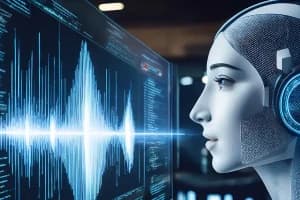The Internet of Things (IoT) is everywhere, with smart thermostats, fitness trackers, and sensors in industries generating huge volumes of data every second. How do you make sense of this data to project trends, such as predicting when a machine is likely to break or when the temperature of a room is likely to change? Time series forecasting involves using data collected over time, and two useful methods-Autoregressive (AR) models and Moving Average (MA) models- can be used for this purpose. In this article, we will describe using an AR and MA model to analyze IoT data and build a simple forecasting model using Python with examples. We will include a sample code and direct you to a project where you can try it yourself. Let us enter into the predictive world of IoT data!
What Are AR and MA Models?
Time series forecasting involves analyzing data points collected over time-like temperature readings from a smart thermostat-to predict future values. AR and MA models are building blocks of more complex forecasting methods like ARIMA, which you might already be familiar with from your past projects.
- Autoregressive (AR) Model: This model is capable of forecasting future amounts based on past amounts. It is like saying if the temperature was 72°F yesterday and 73°F today, the forecast high could be about 74°F or so. The model uses "lag" of past amounts (e.g., the last 2 days) to detect patterns.
- Moving Average (MA) Model: In this modeling technique, we focus on the lagged prediction errors to smooth out the noise in the data. For example, if you have an IoT sensor, sometimes it gives weird readings. This is where just the MA is helpful, as it considers the last set of errors to make future predictions more stable.
Together, AR and MA form the backbone of many time series models, helping you understand patterns in IoT data and make accurate forecasts. They're especially useful for IoT because devices like sensors often produce steady, time-based data with trends and noise.
Why Use AR and MA for IoT Data?
IoT devices-like smart home sensors, wearables, or industrial machines-generate streams of time series data, such as temperature, humidity, or machine vibration levels. AR and MA models are great for this data because.
- Spot Trends Easily: AR captures trends in data, like a gradual increase in room temperature over hours.
- Handle Noise: MA smooths out random fluctuations, like a sensor glitch, to keep predictions reliable.
- Lightweight and Fast: These models are simpler than neural networks, making them ideal for IoT devices with limited processing power.
- Foundation for More: Learning AR and MA sets you up for advanced models like ARIMA or SARIMAX, which you've explored before, by teaching you core time series concepts.
From predicting when a factory machine might need maintenance to forecasting energy usage in a smart home, AR and MA help turn raw IoT data into actionable insights.
How Do AR and MA Models Work?
Using AR and MA to predict IoT data is like teaching a computer to spot patterns in a sequence of numbers. Here's the process:
- Collect IoT Data: Gather time series data, like hourly temperature readings from a smart sensor.
- Check the Data: Ensure it's "stationary" (stable, without wild trends). If not, adjust it with techniques like differencing-a step you've seen in ARIMA projects.
- Choose AR and MA Parameters: Decide how many past values (AR) or errors (MA) to consider. For example, AR(2) uses the last two data points.
- Fit the Model: Train the model on your data to learn patterns, like how temperature changes hour by hour.
- Forecast: Use the model to predict future values, like tomorrow's temperature.
- Evaluate: Compare predictions to actual data (if available) to check accuracy and refine the model.
This approach helps you understand IoT data patterns and predict what's next, making it easier to plan or respond.
Building It: A Simple Code Example
Let's build an ARMA model (which combines AR and MA) to forecast temperature readings from an IoT sensor. We'll use Python with statsmodels, a library you've used in past time series projects, to keep things familiar. This example is beginner-friendly and includes visualization. Know your preference for a clear data presentation.
# Import libraries
import pandas as pd
import numpy as np
from statsmodels.tsa.arima.model import ARIMA
import matplotlib.pyplot as plt
# Sample dataset: hourly temperature readings (in °F) from an IoT sensor
data = pd.Series([
72.1, 72.5, 73.0, 72.8, 73.2, 73.5, 74.0, 74.2, 74.5, 74.8, 75.0, 75.3
], index=pd.date_range(start='2025-04-15 00:00', periods=12, freq='H'))
# Step 1: Fit an ARMA model (ARIMA with no differencing, i.e., ARMA)
# Using AR(2) and MA(1): order=(2,0,1)
model = ARIMA(data, order=(2, 0, 1)).fit()
# Step 2: Forecast the next 3 hours
forecast = model.forecast(steps=3)
forecast_index = pd.date_range(start='2025-04-15 12:00', periods=3, freq='H')
# Step 3: Visualize the data and forecast
plt.plot(data.index, data, label='Actual Temperature', color='blue')
plt.plot(forecast_index, forecast, label='Forecast', color='green', linestyle='--')
plt.xlabel('Time')
plt.ylabel('Temperature (°F)')
plt.title('IoT Temperature Forecasting with ARMA')
plt.legend()
plt.grid(True)
plt.xticks(rotation=45)
plt.tight_layout()
plt.savefig('temperature_forecast.png')
# Step 4: Print the forecast
print("3-Hour Temperature Forecast:")
for date, temp in zip(forecast_index, forecast):
print(f"{date.strftime('%Y-%m-%d %H:%M')}: {temp:.1f} °F")
Output
3-Hour Temperature Forecast:
2025-04-15 12:00: 75.5 °F
2025-04-15 13:00: 75.7 °F
2025-04-15 14:00: 75.9 °F
What's Happening?
- Data Setup: We create a small dataset of 12 hourly temperature readings from an IoT sensor, showing a slight upward trend.
- Model Fitting: We use an ARMA model (ARIMA with no differencing) with AR(2) and MA(1), meaning it looks at the last two temperatures and one past error to predict the next value.
- Forecasting: The model predicts the temperature for the next three hours, estimating a continued rise (e.g., 75.5°F at 12:00).
- Visualization: A plot shows the actual temperatures (blue line) and forecasted values (green dashed line), saved as temperature_forecast.png-a step you've appreciated in past projects for clarity.
Note: This model assumes stationarity; in real IoT data, you might need to check this with tests like ADF, as you've done before with ARIMA.This is a simple example, but it shows how AR and MA can predict IoT trends effectively.
Why AR and MA Are Great for IoT Data
AR and MA models are particularly well-suited for IoT data because:
- Capture Core Patterns: AR spots trends (like rising temperatures), while MA handles noise (like sensor glitches), which is common in IoT streams.
- Efficient for Devices: They're lightweight compared to neural networks, making them practical for resource-constrained IoT devices.
- Scalable Foundation: They're the building blocks of ARIMA, which you've used before, so mastering them sets you up for more advanced forecasting.
- Real-Time Insights: They enable quick predictions, like forecasting energy usage in a smart home to optimize costs.
While they don't handle seasonality (you'd need SARIMA for that), they're a fantastic starting point for understanding IoT data patterns.
Real-World Applications
AR and MA models can transform IoT data into actionable predictions across industries:
- Smart Homes: Predict temperature or energy usage to adjust heating and cooling, saving money and energy.
- Industrial IoT: Forecast machine vibration levels to schedule maintenance before failures, reducing downtime.
- Healthcare Wearables: Analyze heart rate data from a fitness tracker to predict potential health issues.
- Agriculture: Use soil moisture sensor data to forecast irrigation needs, optimizing water usage.
For example, a factory might use AR and MA to predict when a sensor's readings indicate a machine is overheating, preventing costly breakdowns. These models make IoT data more than just numbers-they turn it into decisions.
Try It Yourself
Ready to predict your own IoT data? Dive into this hands-on project: Build an Autoregressive and Moving Average Time Series Model. Hosted by AI Online Course, this beginner-friendly playground lets you experiment with AR and MA models on real time series data. Try forecasting sensor readings, energy usage, or even stock prices, and see how your predictions stack up-it's a practical way to master time series forecasting. Start exploring today!
Tips for Better IoT Forecasting
Here are some quick tips to improve your AR and MA models, building on techniques you've used in past time series projects:
- Ensure Stationarity: Use tests like ADF (Augmented Dickey-Fuller), which you've encountered with ARIMA, to check if your data is stable, or apply differencing.
- Choose Parameters Wisely: Experiment with AR and MA orders (e.g., AR(1), MA(2)) or use tools like auto_arima to automate selection.
- Handle Noise: IoT data can be messy-use MA to smooth out sensor errors, and preprocess data to remove outliers.
- Visualize Results: Always plot your forecasts against actual data, as we did, to spot errors and build trust in your model-a step you've found helpful before.
- Scale Up: Once you're comfortable, combine AR and MA into ARIMA or SARIMA to handle trends and seasonality, as you've done in previous projects.
These steps will help you get the most out of AR and MA while preparing you for more complex IoT forecasting challenges.
Conclusion
Using AR and MA models to understand and predict IoT data is like giving your smart devices a crystal ball. By spotting trends and smoothing out noise, these models turn raw sensor data into meaningful forecasts-whether it's predicting room temperature, machine health, or energy usage. They're simple to implement, efficient for IoT applications, and a great stepping stone to more advanced techniques like ARIMA, which you've already explored. With Python, a bit of data, and the steps above, you're ready to start forecasting IoT trends like a pro. Head to the project linked above, grab some IoT data, and see what the future holds-happy forecasting!






